BUSM4554 Contemporary Management: Amazon Case Study Analysis
VerifiedAdded on 2022/09/18
|12
|3164
|29
Case Study
AI Summary
This case study examines the contemporary management practices of Amazon, focusing on the issues and challenges the company faces, particularly concerning its employees. The analysis identifies problems such as unreasonable expectations, high employee turnover, and a demanding work environment. The study explores the strategies Amazon could implement to address these issues, including improving employee retention, offering stock options, and providing employee training. It also highlights the risks associated with not addressing these challenges, such as lowered target achievement and ethical concerns. The case study recommends changes in Amazon's policies, advocating for a high retention strategy, enhanced reward and performance systems, and the application of McGregor's Two-Factor Theory and Pfeffer's seven best practices to improve employee satisfaction and overall business performance. The assignment provides a comprehensive overview of Amazon's management practices and suggests actionable recommendations for improvement.
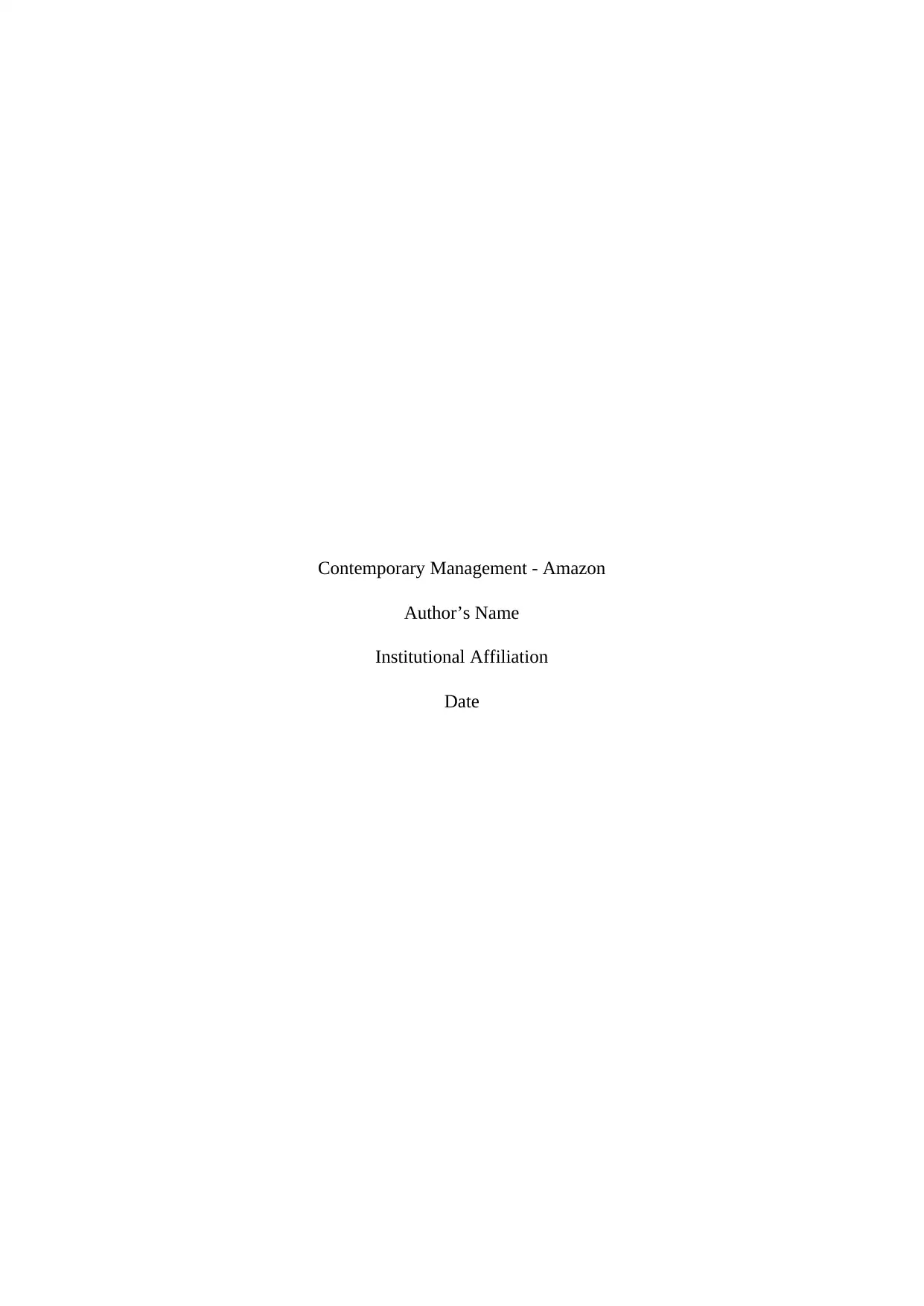
Contemporary Management - Amazon
Author’s Name
Institutional Affiliation
Date
Author’s Name
Institutional Affiliation
Date
Secure Best Marks with AI Grader
Need help grading? Try our AI Grader for instant feedback on your assignments.

Executive Summary

Table of Contents
Introduction......................................................................................................................................................4
Amazon Issues and Challenges – Problem Identification..............................................................................4
Strategies to Address Issues and Challenges for Amazon.............................................................................6
Risks if Issues and Challenges are not addressed..........................................................................................7
Recommendation to Amazon...........................................................................................................................8
References.......................................................................................................................................................10
Introduction......................................................................................................................................................4
Amazon Issues and Challenges – Problem Identification..............................................................................4
Strategies to Address Issues and Challenges for Amazon.............................................................................6
Risks if Issues and Challenges are not addressed..........................................................................................7
Recommendation to Amazon...........................................................................................................................8
References.......................................................................................................................................................10
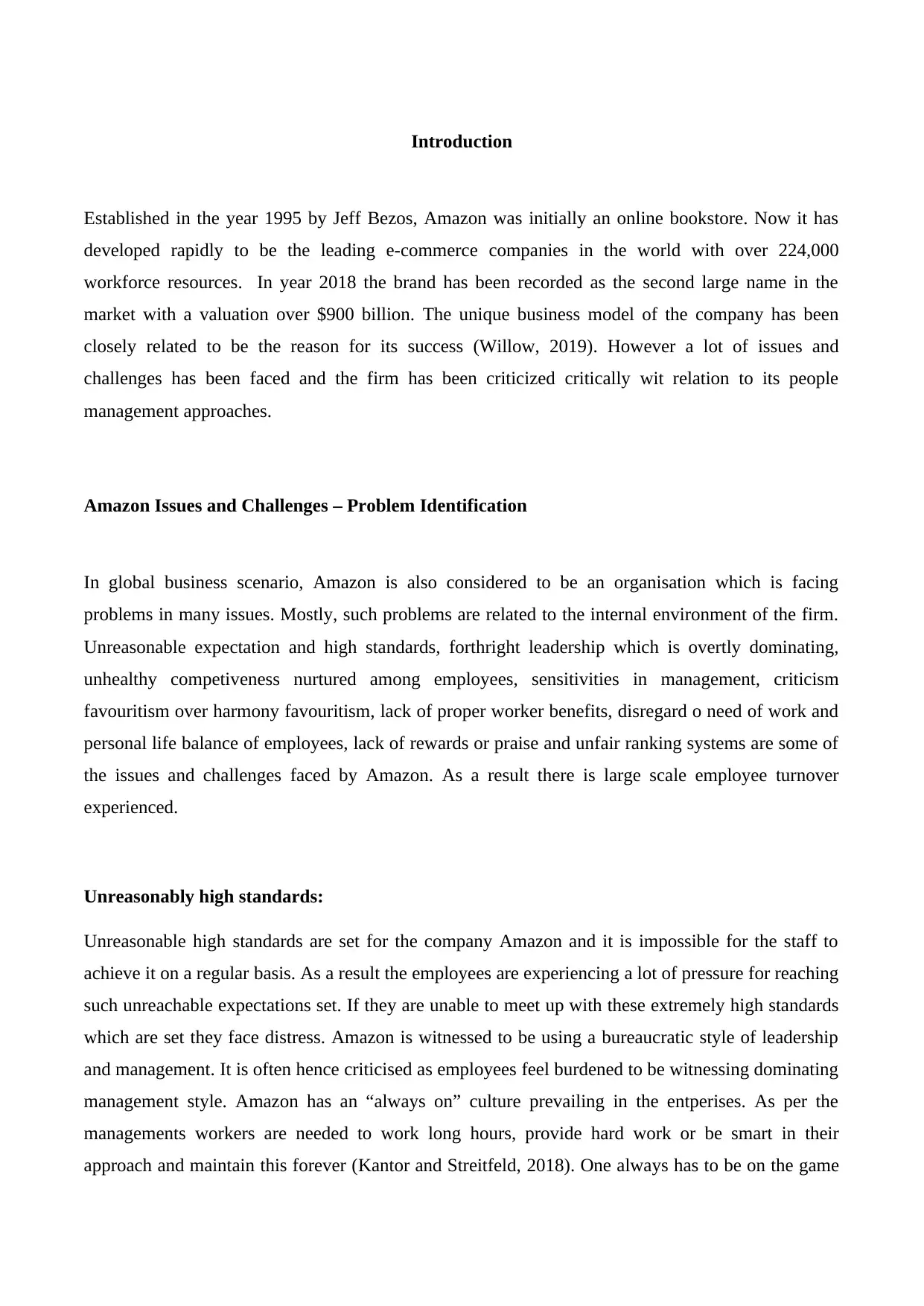
Introduction
Established in the year 1995 by Jeff Bezos, Amazon was initially an online bookstore. Now it has
developed rapidly to be the leading e-commerce companies in the world with over 224,000
workforce resources. In year 2018 the brand has been recorded as the second large name in the
market with a valuation over $900 billion. The unique business model of the company has been
closely related to be the reason for its success (Willow, 2019). However a lot of issues and
challenges has been faced and the firm has been criticized critically wit relation to its people
management approaches.
Amazon Issues and Challenges – Problem Identification
In global business scenario, Amazon is also considered to be an organisation which is facing
problems in many issues. Mostly, such problems are related to the internal environment of the firm.
Unreasonable expectation and high standards, forthright leadership which is overtly dominating,
unhealthy competiveness nurtured among employees, sensitivities in management, criticism
favouritism over harmony favouritism, lack of proper worker benefits, disregard o need of work and
personal life balance of employees, lack of rewards or praise and unfair ranking systems are some of
the issues and challenges faced by Amazon. As a result there is large scale employee turnover
experienced.
Unreasonably high standards:
Unreasonable high standards are set for the company Amazon and it is impossible for the staff to
achieve it on a regular basis. As a result the employees are experiencing a lot of pressure for reaching
such unreachable expectations set. If they are unable to meet up with these extremely high standards
which are set they face distress. Amazon is witnessed to be using a bureaucratic style of leadership
and management. It is often hence criticised as employees feel burdened to be witnessing dominating
management style. Amazon has an “always on” culture prevailing in the entperises. As per the
managements workers are needed to work long hours, provide hard work or be smart in their
approach and maintain this forever (Kantor and Streitfeld, 2018). One always has to be on the game
Established in the year 1995 by Jeff Bezos, Amazon was initially an online bookstore. Now it has
developed rapidly to be the leading e-commerce companies in the world with over 224,000
workforce resources. In year 2018 the brand has been recorded as the second large name in the
market with a valuation over $900 billion. The unique business model of the company has been
closely related to be the reason for its success (Willow, 2019). However a lot of issues and
challenges has been faced and the firm has been criticized critically wit relation to its people
management approaches.
Amazon Issues and Challenges – Problem Identification
In global business scenario, Amazon is also considered to be an organisation which is facing
problems in many issues. Mostly, such problems are related to the internal environment of the firm.
Unreasonable expectation and high standards, forthright leadership which is overtly dominating,
unhealthy competiveness nurtured among employees, sensitivities in management, criticism
favouritism over harmony favouritism, lack of proper worker benefits, disregard o need of work and
personal life balance of employees, lack of rewards or praise and unfair ranking systems are some of
the issues and challenges faced by Amazon. As a result there is large scale employee turnover
experienced.
Unreasonably high standards:
Unreasonable high standards are set for the company Amazon and it is impossible for the staff to
achieve it on a regular basis. As a result the employees are experiencing a lot of pressure for reaching
such unreachable expectations set. If they are unable to meet up with these extremely high standards
which are set they face distress. Amazon is witnessed to be using a bureaucratic style of leadership
and management. It is often hence criticised as employees feel burdened to be witnessing dominating
management style. Amazon has an “always on” culture prevailing in the entperises. As per the
managements workers are needed to work long hours, provide hard work or be smart in their
approach and maintain this forever (Kantor and Streitfeld, 2018). One always has to be on the game
Secure Best Marks with AI Grader
Need help grading? Try our AI Grader for instant feedback on your assignments.
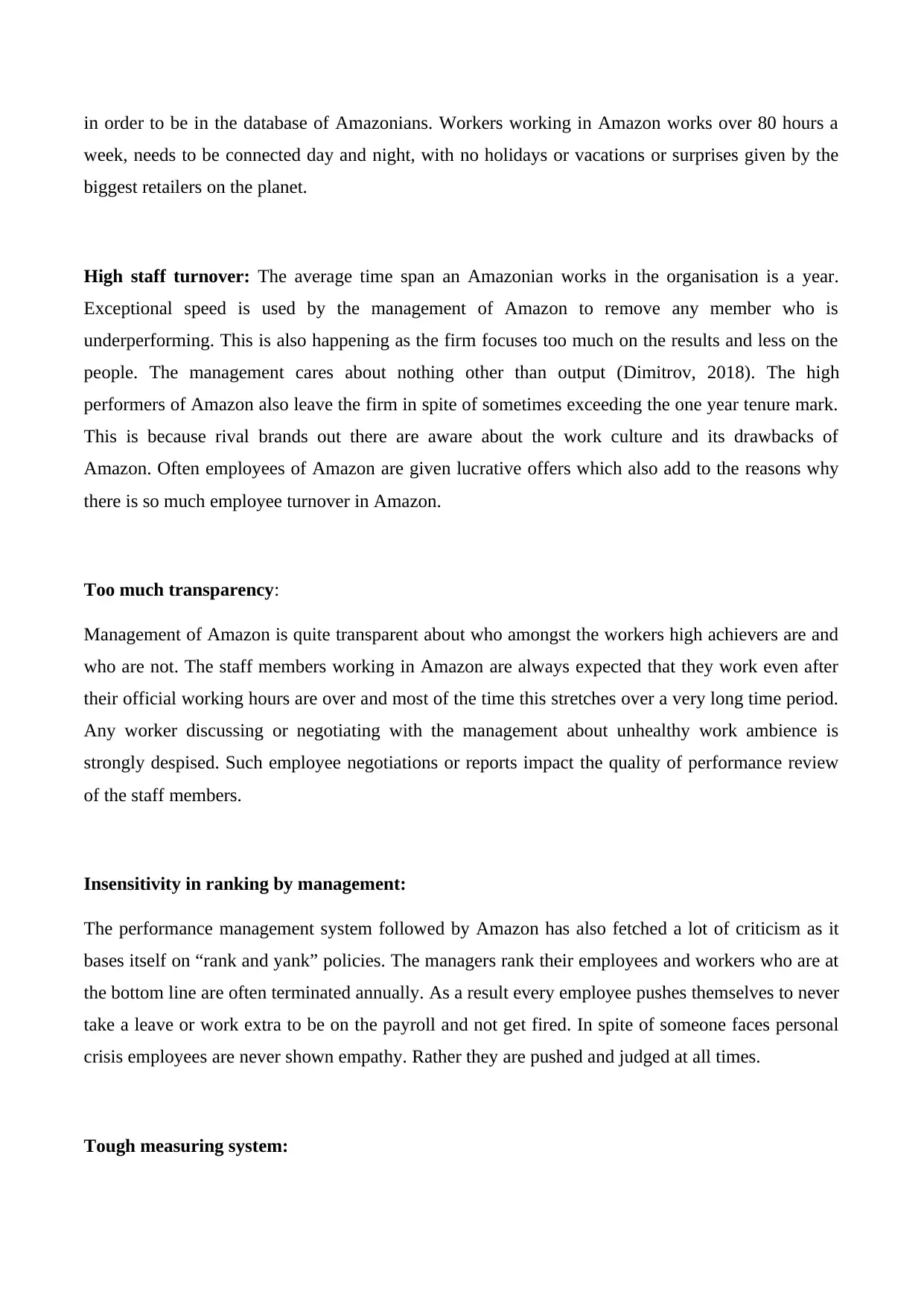
in order to be in the database of Amazonians. Workers working in Amazon works over 80 hours a
week, needs to be connected day and night, with no holidays or vacations or surprises given by the
biggest retailers on the planet.
High staff turnover: The average time span an Amazonian works in the organisation is a year.
Exceptional speed is used by the management of Amazon to remove any member who is
underperforming. This is also happening as the firm focuses too much on the results and less on the
people. The management cares about nothing other than output (Dimitrov, 2018). The high
performers of Amazon also leave the firm in spite of sometimes exceeding the one year tenure mark.
This is because rival brands out there are aware about the work culture and its drawbacks of
Amazon. Often employees of Amazon are given lucrative offers which also add to the reasons why
there is so much employee turnover in Amazon.
Too much transparency:
Management of Amazon is quite transparent about who amongst the workers high achievers are and
who are not. The staff members working in Amazon are always expected that they work even after
their official working hours are over and most of the time this stretches over a very long time period.
Any worker discussing or negotiating with the management about unhealthy work ambience is
strongly despised. Such employee negotiations or reports impact the quality of performance review
of the staff members.
Insensitivity in ranking by management:
The performance management system followed by Amazon has also fetched a lot of criticism as it
bases itself on “rank and yank” policies. The managers rank their employees and workers who are at
the bottom line are often terminated annually. As a result every employee pushes themselves to never
take a leave or work extra to be on the payroll and not get fired. In spite of someone faces personal
crisis employees are never shown empathy. Rather they are pushed and judged at all times.
Tough measuring system:
week, needs to be connected day and night, with no holidays or vacations or surprises given by the
biggest retailers on the planet.
High staff turnover: The average time span an Amazonian works in the organisation is a year.
Exceptional speed is used by the management of Amazon to remove any member who is
underperforming. This is also happening as the firm focuses too much on the results and less on the
people. The management cares about nothing other than output (Dimitrov, 2018). The high
performers of Amazon also leave the firm in spite of sometimes exceeding the one year tenure mark.
This is because rival brands out there are aware about the work culture and its drawbacks of
Amazon. Often employees of Amazon are given lucrative offers which also add to the reasons why
there is so much employee turnover in Amazon.
Too much transparency:
Management of Amazon is quite transparent about who amongst the workers high achievers are and
who are not. The staff members working in Amazon are always expected that they work even after
their official working hours are over and most of the time this stretches over a very long time period.
Any worker discussing or negotiating with the management about unhealthy work ambience is
strongly despised. Such employee negotiations or reports impact the quality of performance review
of the staff members.
Insensitivity in ranking by management:
The performance management system followed by Amazon has also fetched a lot of criticism as it
bases itself on “rank and yank” policies. The managers rank their employees and workers who are at
the bottom line are often terminated annually. As a result every employee pushes themselves to never
take a leave or work extra to be on the payroll and not get fired. In spite of someone faces personal
crisis employees are never shown empathy. Rather they are pushed and judged at all times.
Tough measuring system:
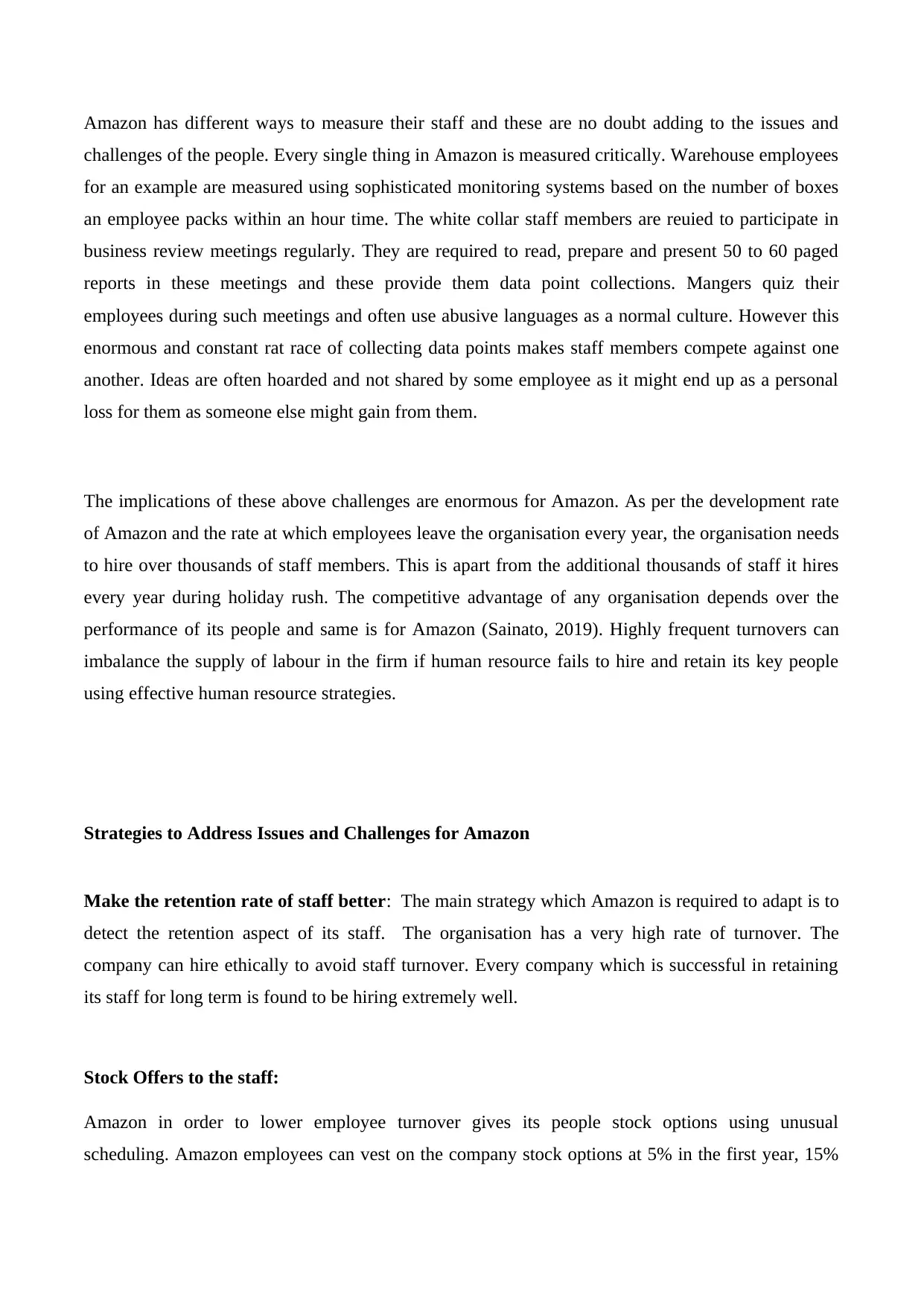
Amazon has different ways to measure their staff and these are no doubt adding to the issues and
challenges of the people. Every single thing in Amazon is measured critically. Warehouse employees
for an example are measured using sophisticated monitoring systems based on the number of boxes
an employee packs within an hour time. The white collar staff members are reuied to participate in
business review meetings regularly. They are required to read, prepare and present 50 to 60 paged
reports in these meetings and these provide them data point collections. Mangers quiz their
employees during such meetings and often use abusive languages as a normal culture. However this
enormous and constant rat race of collecting data points makes staff members compete against one
another. Ideas are often hoarded and not shared by some employee as it might end up as a personal
loss for them as someone else might gain from them.
The implications of these above challenges are enormous for Amazon. As per the development rate
of Amazon and the rate at which employees leave the organisation every year, the organisation needs
to hire over thousands of staff members. This is apart from the additional thousands of staff it hires
every year during holiday rush. The competitive advantage of any organisation depends over the
performance of its people and same is for Amazon (Sainato, 2019). Highly frequent turnovers can
imbalance the supply of labour in the firm if human resource fails to hire and retain its key people
using effective human resource strategies.
Strategies to Address Issues and Challenges for Amazon
Make the retention rate of staff better: The main strategy which Amazon is required to adapt is to
detect the retention aspect of its staff. The organisation has a very high rate of turnover. The
company can hire ethically to avoid staff turnover. Every company which is successful in retaining
its staff for long term is found to be hiring extremely well.
Stock Offers to the staff:
Amazon in order to lower employee turnover gives its people stock options using unusual
scheduling. Amazon employees can vest on the company stock options at 5% in the first year, 15%
challenges of the people. Every single thing in Amazon is measured critically. Warehouse employees
for an example are measured using sophisticated monitoring systems based on the number of boxes
an employee packs within an hour time. The white collar staff members are reuied to participate in
business review meetings regularly. They are required to read, prepare and present 50 to 60 paged
reports in these meetings and these provide them data point collections. Mangers quiz their
employees during such meetings and often use abusive languages as a normal culture. However this
enormous and constant rat race of collecting data points makes staff members compete against one
another. Ideas are often hoarded and not shared by some employee as it might end up as a personal
loss for them as someone else might gain from them.
The implications of these above challenges are enormous for Amazon. As per the development rate
of Amazon and the rate at which employees leave the organisation every year, the organisation needs
to hire over thousands of staff members. This is apart from the additional thousands of staff it hires
every year during holiday rush. The competitive advantage of any organisation depends over the
performance of its people and same is for Amazon (Sainato, 2019). Highly frequent turnovers can
imbalance the supply of labour in the firm if human resource fails to hire and retain its key people
using effective human resource strategies.
Strategies to Address Issues and Challenges for Amazon
Make the retention rate of staff better: The main strategy which Amazon is required to adapt is to
detect the retention aspect of its staff. The organisation has a very high rate of turnover. The
company can hire ethically to avoid staff turnover. Every company which is successful in retaining
its staff for long term is found to be hiring extremely well.
Stock Offers to the staff:
Amazon in order to lower employee turnover gives its people stock options using unusual
scheduling. Amazon employees can vest on the company stock options at 5% in the first year, 15%
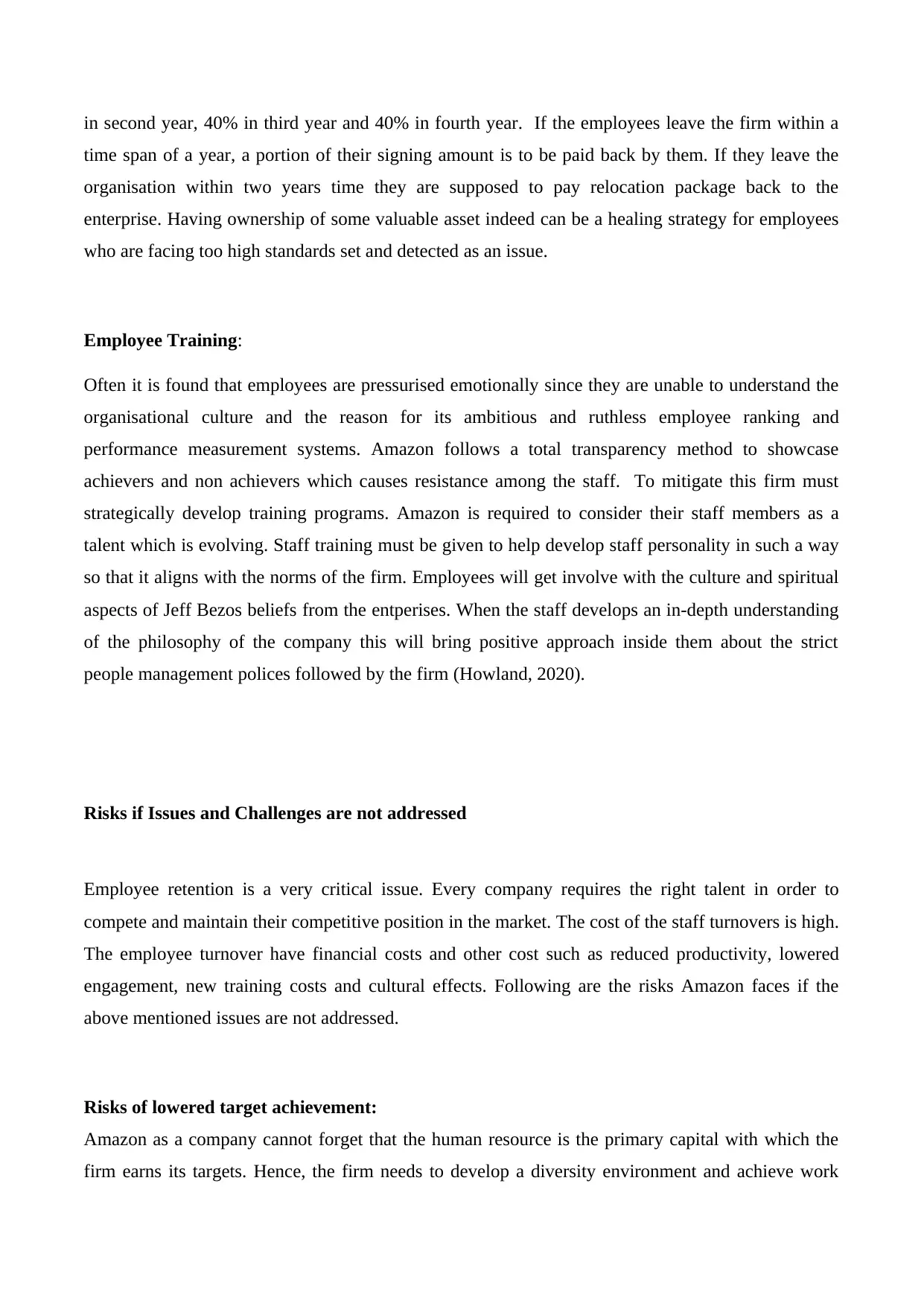
in second year, 40% in third year and 40% in fourth year. If the employees leave the firm within a
time span of a year, a portion of their signing amount is to be paid back by them. If they leave the
organisation within two years time they are supposed to pay relocation package back to the
enterprise. Having ownership of some valuable asset indeed can be a healing strategy for employees
who are facing too high standards set and detected as an issue.
Employee Training:
Often it is found that employees are pressurised emotionally since they are unable to understand the
organisational culture and the reason for its ambitious and ruthless employee ranking and
performance measurement systems. Amazon follows a total transparency method to showcase
achievers and non achievers which causes resistance among the staff. To mitigate this firm must
strategically develop training programs. Amazon is required to consider their staff members as a
talent which is evolving. Staff training must be given to help develop staff personality in such a way
so that it aligns with the norms of the firm. Employees will get involve with the culture and spiritual
aspects of Jeff Bezos beliefs from the entperises. When the staff develops an in-depth understanding
of the philosophy of the company this will bring positive approach inside them about the strict
people management polices followed by the firm (Howland, 2020).
Risks if Issues and Challenges are not addressed
Employee retention is a very critical issue. Every company requires the right talent in order to
compete and maintain their competitive position in the market. The cost of the staff turnovers is high.
The employee turnover have financial costs and other cost such as reduced productivity, lowered
engagement, new training costs and cultural effects. Following are the risks Amazon faces if the
above mentioned issues are not addressed.
Risks of lowered target achievement:
Amazon as a company cannot forget that the human resource is the primary capital with which the
firm earns its targets. Hence, the firm needs to develop a diversity environment and achieve work
time span of a year, a portion of their signing amount is to be paid back by them. If they leave the
organisation within two years time they are supposed to pay relocation package back to the
enterprise. Having ownership of some valuable asset indeed can be a healing strategy for employees
who are facing too high standards set and detected as an issue.
Employee Training:
Often it is found that employees are pressurised emotionally since they are unable to understand the
organisational culture and the reason for its ambitious and ruthless employee ranking and
performance measurement systems. Amazon follows a total transparency method to showcase
achievers and non achievers which causes resistance among the staff. To mitigate this firm must
strategically develop training programs. Amazon is required to consider their staff members as a
talent which is evolving. Staff training must be given to help develop staff personality in such a way
so that it aligns with the norms of the firm. Employees will get involve with the culture and spiritual
aspects of Jeff Bezos beliefs from the entperises. When the staff develops an in-depth understanding
of the philosophy of the company this will bring positive approach inside them about the strict
people management polices followed by the firm (Howland, 2020).
Risks if Issues and Challenges are not addressed
Employee retention is a very critical issue. Every company requires the right talent in order to
compete and maintain their competitive position in the market. The cost of the staff turnovers is high.
The employee turnover have financial costs and other cost such as reduced productivity, lowered
engagement, new training costs and cultural effects. Following are the risks Amazon faces if the
above mentioned issues are not addressed.
Risks of lowered target achievement:
Amazon as a company cannot forget that the human resource is the primary capital with which the
firm earns its targets. Hence, the firm needs to develop a diversity environment and achieve work
Paraphrase This Document
Need a fresh take? Get an instant paraphrase of this document with our AI Paraphraser
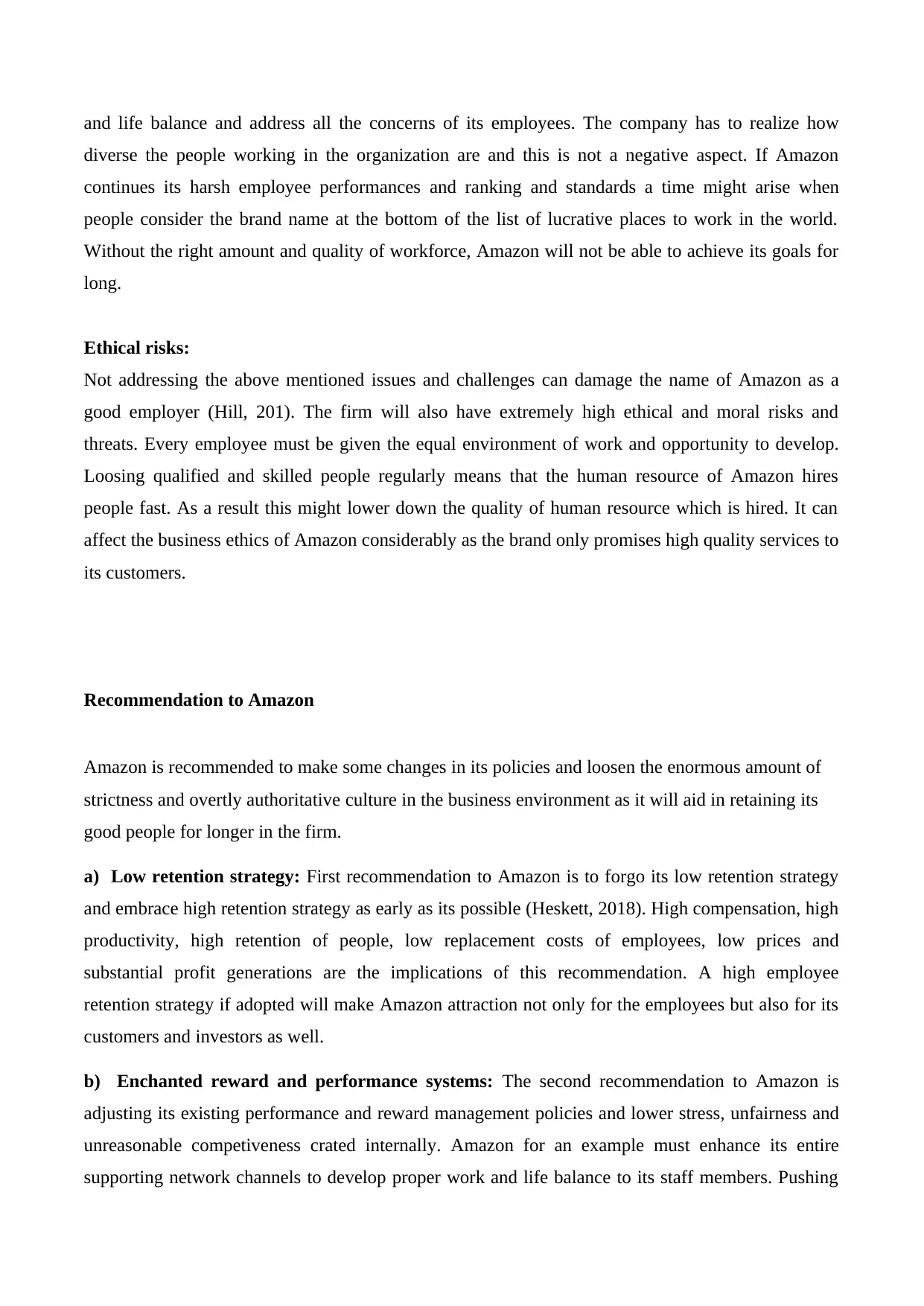
and life balance and address all the concerns of its employees. The company has to realize how
diverse the people working in the organization are and this is not a negative aspect. If Amazon
continues its harsh employee performances and ranking and standards a time might arise when
people consider the brand name at the bottom of the list of lucrative places to work in the world.
Without the right amount and quality of workforce, Amazon will not be able to achieve its goals for
long.
Ethical risks:
Not addressing the above mentioned issues and challenges can damage the name of Amazon as a
good employer (Hill, 201). The firm will also have extremely high ethical and moral risks and
threats. Every employee must be given the equal environment of work and opportunity to develop.
Loosing qualified and skilled people regularly means that the human resource of Amazon hires
people fast. As a result this might lower down the quality of human resource which is hired. It can
affect the business ethics of Amazon considerably as the brand only promises high quality services to
its customers.
Recommendation to Amazon
Amazon is recommended to make some changes in its policies and loosen the enormous amount of
strictness and overtly authoritative culture in the business environment as it will aid in retaining its
good people for longer in the firm.
a) Low retention strategy: First recommendation to Amazon is to forgo its low retention strategy
and embrace high retention strategy as early as its possible (Heskett, 2018). High compensation, high
productivity, high retention of people, low replacement costs of employees, low prices and
substantial profit generations are the implications of this recommendation. A high employee
retention strategy if adopted will make Amazon attraction not only for the employees but also for its
customers and investors as well.
b) Enchanted reward and performance systems: The second recommendation to Amazon is
adjusting its existing performance and reward management policies and lower stress, unfairness and
unreasonable competiveness crated internally. Amazon for an example must enhance its entire
supporting network channels to develop proper work and life balance to its staff members. Pushing
diverse the people working in the organization are and this is not a negative aspect. If Amazon
continues its harsh employee performances and ranking and standards a time might arise when
people consider the brand name at the bottom of the list of lucrative places to work in the world.
Without the right amount and quality of workforce, Amazon will not be able to achieve its goals for
long.
Ethical risks:
Not addressing the above mentioned issues and challenges can damage the name of Amazon as a
good employer (Hill, 201). The firm will also have extremely high ethical and moral risks and
threats. Every employee must be given the equal environment of work and opportunity to develop.
Loosing qualified and skilled people regularly means that the human resource of Amazon hires
people fast. As a result this might lower down the quality of human resource which is hired. It can
affect the business ethics of Amazon considerably as the brand only promises high quality services to
its customers.
Recommendation to Amazon
Amazon is recommended to make some changes in its policies and loosen the enormous amount of
strictness and overtly authoritative culture in the business environment as it will aid in retaining its
good people for longer in the firm.
a) Low retention strategy: First recommendation to Amazon is to forgo its low retention strategy
and embrace high retention strategy as early as its possible (Heskett, 2018). High compensation, high
productivity, high retention of people, low replacement costs of employees, low prices and
substantial profit generations are the implications of this recommendation. A high employee
retention strategy if adopted will make Amazon attraction not only for the employees but also for its
customers and investors as well.
b) Enchanted reward and performance systems: The second recommendation to Amazon is
adjusting its existing performance and reward management policies and lower stress, unfairness and
unreasonable competiveness crated internally. Amazon for an example must enhance its entire
supporting network channels to develop proper work and life balance to its staff members. Pushing
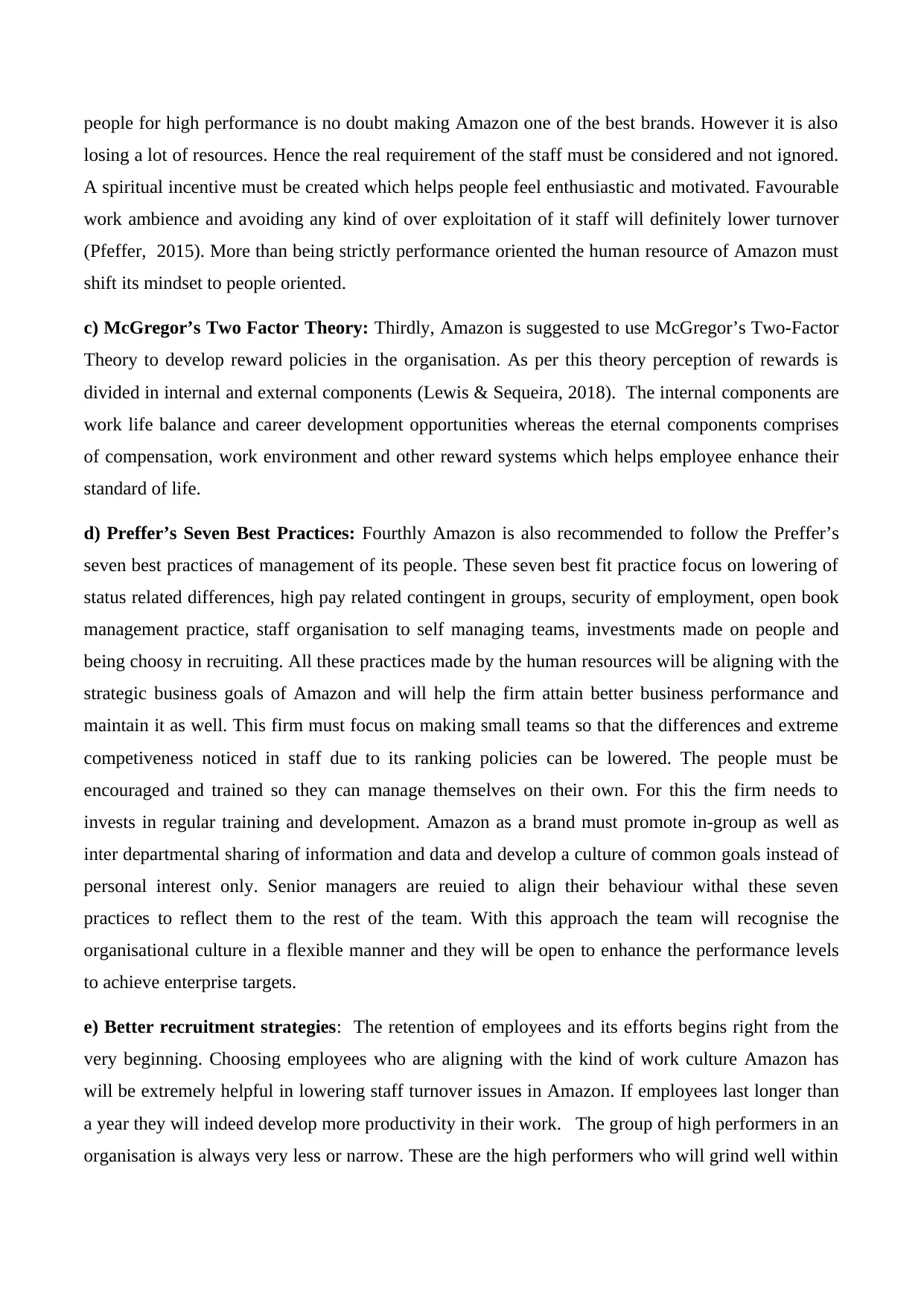
people for high performance is no doubt making Amazon one of the best brands. However it is also
losing a lot of resources. Hence the real requirement of the staff must be considered and not ignored.
A spiritual incentive must be created which helps people feel enthusiastic and motivated. Favourable
work ambience and avoiding any kind of over exploitation of it staff will definitely lower turnover
(Pfeffer, 2015). More than being strictly performance oriented the human resource of Amazon must
shift its mindset to people oriented.
c) McGregor’s Two Factor Theory: Thirdly, Amazon is suggested to use McGregor’s Two-Factor
Theory to develop reward policies in the organisation. As per this theory perception of rewards is
divided in internal and external components (Lewis & Sequeira, 2018). The internal components are
work life balance and career development opportunities whereas the eternal components comprises
of compensation, work environment and other reward systems which helps employee enhance their
standard of life.
d) Preffer’s Seven Best Practices: Fourthly Amazon is also recommended to follow the Preffer’s
seven best practices of management of its people. These seven best fit practice focus on lowering of
status related differences, high pay related contingent in groups, security of employment, open book
management practice, staff organisation to self managing teams, investments made on people and
being choosy in recruiting. All these practices made by the human resources will be aligning with the
strategic business goals of Amazon and will help the firm attain better business performance and
maintain it as well. This firm must focus on making small teams so that the differences and extreme
competiveness noticed in staff due to its ranking policies can be lowered. The people must be
encouraged and trained so they can manage themselves on their own. For this the firm needs to
invests in regular training and development. Amazon as a brand must promote in-group as well as
inter departmental sharing of information and data and develop a culture of common goals instead of
personal interest only. Senior managers are reuied to align their behaviour withal these seven
practices to reflect them to the rest of the team. With this approach the team will recognise the
organisational culture in a flexible manner and they will be open to enhance the performance levels
to achieve enterprise targets.
e) Better recruitment strategies: The retention of employees and its efforts begins right from the
very beginning. Choosing employees who are aligning with the kind of work culture Amazon has
will be extremely helpful in lowering staff turnover issues in Amazon. If employees last longer than
a year they will indeed develop more productivity in their work. The group of high performers in an
organisation is always very less or narrow. These are the high performers who will grind well within
losing a lot of resources. Hence the real requirement of the staff must be considered and not ignored.
A spiritual incentive must be created which helps people feel enthusiastic and motivated. Favourable
work ambience and avoiding any kind of over exploitation of it staff will definitely lower turnover
(Pfeffer, 2015). More than being strictly performance oriented the human resource of Amazon must
shift its mindset to people oriented.
c) McGregor’s Two Factor Theory: Thirdly, Amazon is suggested to use McGregor’s Two-Factor
Theory to develop reward policies in the organisation. As per this theory perception of rewards is
divided in internal and external components (Lewis & Sequeira, 2018). The internal components are
work life balance and career development opportunities whereas the eternal components comprises
of compensation, work environment and other reward systems which helps employee enhance their
standard of life.
d) Preffer’s Seven Best Practices: Fourthly Amazon is also recommended to follow the Preffer’s
seven best practices of management of its people. These seven best fit practice focus on lowering of
status related differences, high pay related contingent in groups, security of employment, open book
management practice, staff organisation to self managing teams, investments made on people and
being choosy in recruiting. All these practices made by the human resources will be aligning with the
strategic business goals of Amazon and will help the firm attain better business performance and
maintain it as well. This firm must focus on making small teams so that the differences and extreme
competiveness noticed in staff due to its ranking policies can be lowered. The people must be
encouraged and trained so they can manage themselves on their own. For this the firm needs to
invests in regular training and development. Amazon as a brand must promote in-group as well as
inter departmental sharing of information and data and develop a culture of common goals instead of
personal interest only. Senior managers are reuied to align their behaviour withal these seven
practices to reflect them to the rest of the team. With this approach the team will recognise the
organisational culture in a flexible manner and they will be open to enhance the performance levels
to achieve enterprise targets.
e) Better recruitment strategies: The retention of employees and its efforts begins right from the
very beginning. Choosing employees who are aligning with the kind of work culture Amazon has
will be extremely helpful in lowering staff turnover issues in Amazon. If employees last longer than
a year they will indeed develop more productivity in their work. The group of high performers in an
organisation is always very less or narrow. These are the high performers who will grind well within
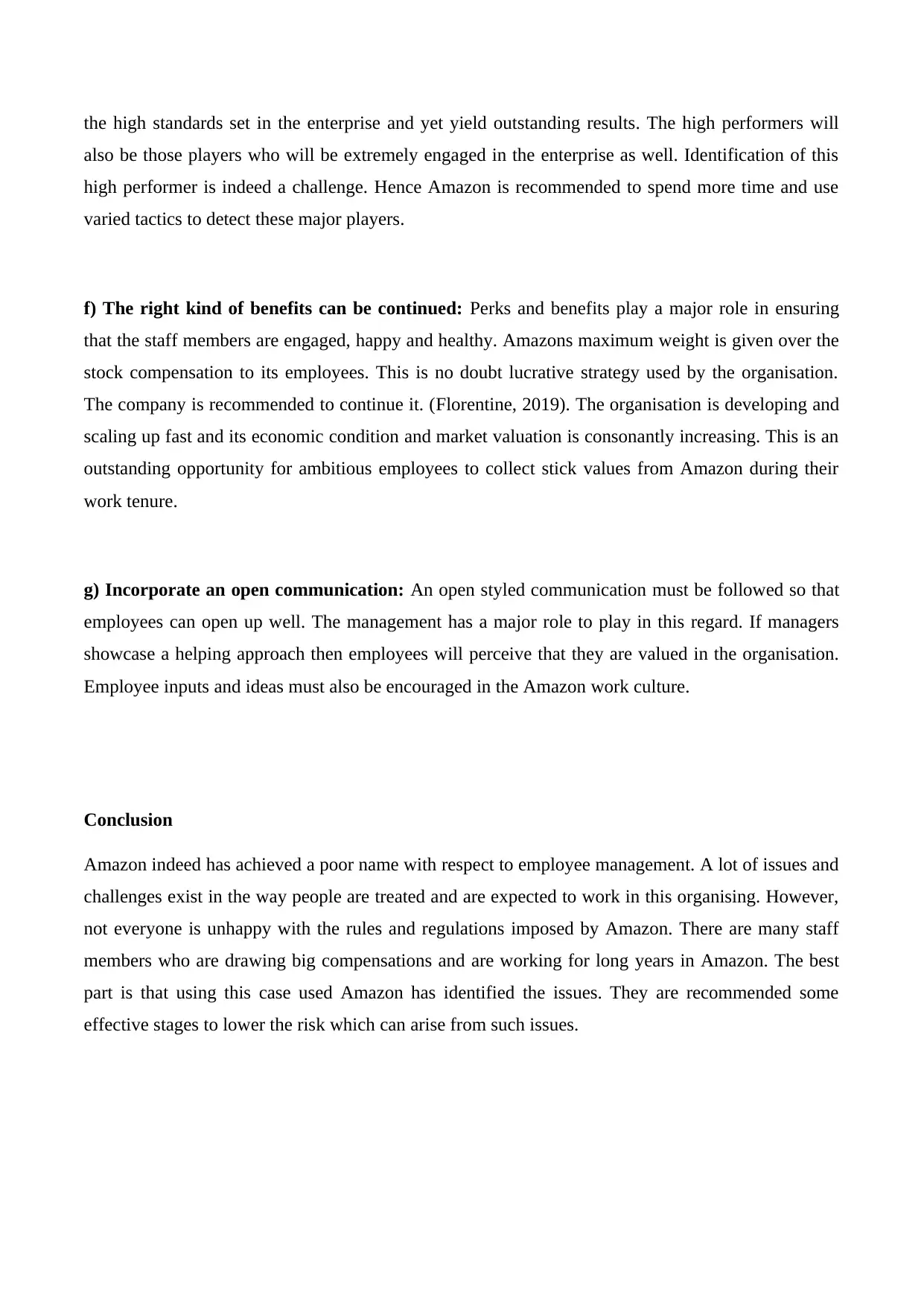
the high standards set in the enterprise and yet yield outstanding results. The high performers will
also be those players who will be extremely engaged in the enterprise as well. Identification of this
high performer is indeed a challenge. Hence Amazon is recommended to spend more time and use
varied tactics to detect these major players.
f) The right kind of benefits can be continued: Perks and benefits play a major role in ensuring
that the staff members are engaged, happy and healthy. Amazons maximum weight is given over the
stock compensation to its employees. This is no doubt lucrative strategy used by the organisation.
The company is recommended to continue it. (Florentine, 2019). The organisation is developing and
scaling up fast and its economic condition and market valuation is consonantly increasing. This is an
outstanding opportunity for ambitious employees to collect stick values from Amazon during their
work tenure.
g) Incorporate an open communication: An open styled communication must be followed so that
employees can open up well. The management has a major role to play in this regard. If managers
showcase a helping approach then employees will perceive that they are valued in the organisation.
Employee inputs and ideas must also be encouraged in the Amazon work culture.
Conclusion
Amazon indeed has achieved a poor name with respect to employee management. A lot of issues and
challenges exist in the way people are treated and are expected to work in this organising. However,
not everyone is unhappy with the rules and regulations imposed by Amazon. There are many staff
members who are drawing big compensations and are working for long years in Amazon. The best
part is that using this case used Amazon has identified the issues. They are recommended some
effective stages to lower the risk which can arise from such issues.
also be those players who will be extremely engaged in the enterprise as well. Identification of this
high performer is indeed a challenge. Hence Amazon is recommended to spend more time and use
varied tactics to detect these major players.
f) The right kind of benefits can be continued: Perks and benefits play a major role in ensuring
that the staff members are engaged, happy and healthy. Amazons maximum weight is given over the
stock compensation to its employees. This is no doubt lucrative strategy used by the organisation.
The company is recommended to continue it. (Florentine, 2019). The organisation is developing and
scaling up fast and its economic condition and market valuation is consonantly increasing. This is an
outstanding opportunity for ambitious employees to collect stick values from Amazon during their
work tenure.
g) Incorporate an open communication: An open styled communication must be followed so that
employees can open up well. The management has a major role to play in this regard. If managers
showcase a helping approach then employees will perceive that they are valued in the organisation.
Employee inputs and ideas must also be encouraged in the Amazon work culture.
Conclusion
Amazon indeed has achieved a poor name with respect to employee management. A lot of issues and
challenges exist in the way people are treated and are expected to work in this organising. However,
not everyone is unhappy with the rules and regulations imposed by Amazon. There are many staff
members who are drawing big compensations and are working for long years in Amazon. The best
part is that using this case used Amazon has identified the issues. They are recommended some
effective stages to lower the risk which can arise from such issues.
Secure Best Marks with AI Grader
Need help grading? Try our AI Grader for instant feedback on your assignments.
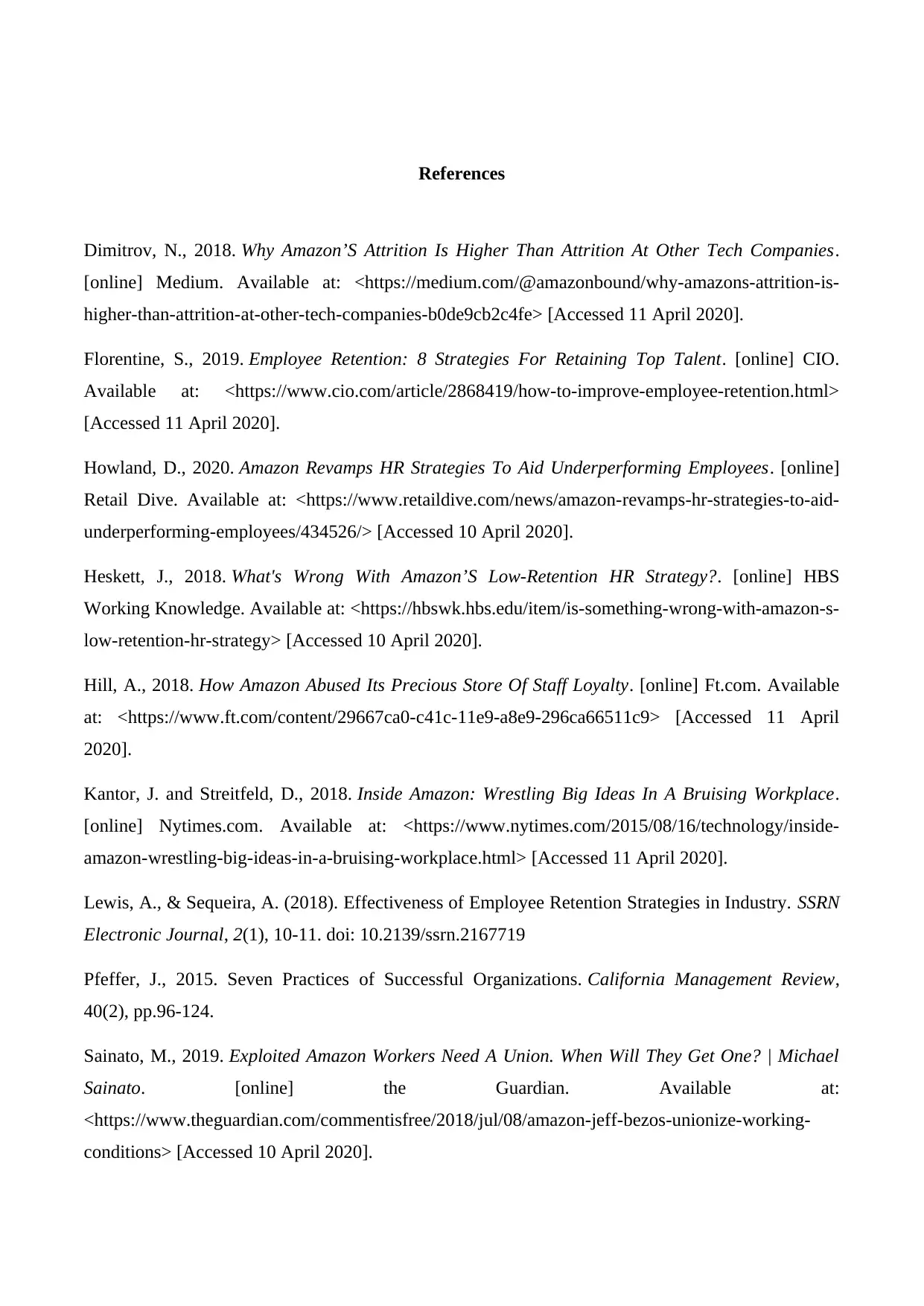
References
Dimitrov, N., 2018. Why Amazon’S Attrition Is Higher Than Attrition At Other Tech Companies.
[online] Medium. Available at: <https://medium.com/@amazonbound/why-amazons-attrition-is-
higher-than-attrition-at-other-tech-companies-b0de9cb2c4fe> [Accessed 11 April 2020].
Florentine, S., 2019. Employee Retention: 8 Strategies For Retaining Top Talent. [online] CIO.
Available at: <https://www.cio.com/article/2868419/how-to-improve-employee-retention.html>
[Accessed 11 April 2020].
Howland, D., 2020. Amazon Revamps HR Strategies To Aid Underperforming Employees. [online]
Retail Dive. Available at: <https://www.retaildive.com/news/amazon-revamps-hr-strategies-to-aid-
underperforming-employees/434526/> [Accessed 10 April 2020].
Heskett, J., 2018. What's Wrong With Amazon’S Low-Retention HR Strategy?. [online] HBS
Working Knowledge. Available at: <https://hbswk.hbs.edu/item/is-something-wrong-with-amazon-s-
low-retention-hr-strategy> [Accessed 10 April 2020].
Hill, A., 2018. How Amazon Abused Its Precious Store Of Staff Loyalty. [online] Ft.com. Available
at: <https://www.ft.com/content/29667ca0-c41c-11e9-a8e9-296ca66511c9> [Accessed 11 April
2020].
Kantor, J. and Streitfeld, D., 2018. Inside Amazon: Wrestling Big Ideas In A Bruising Workplace.
[online] Nytimes.com. Available at: <https://www.nytimes.com/2015/08/16/technology/inside-
amazon-wrestling-big-ideas-in-a-bruising-workplace.html> [Accessed 11 April 2020].
Lewis, A., & Sequeira, A. (2018). Effectiveness of Employee Retention Strategies in Industry. SSRN
Electronic Journal, 2(1), 10-11. doi: 10.2139/ssrn.2167719
Pfeffer, J., 2015. Seven Practices of Successful Organizations. California Management Review,
40(2), pp.96-124.
Sainato, M., 2019. Exploited Amazon Workers Need A Union. When Will They Get One? | Michael
Sainato. [online] the Guardian. Available at:
<https://www.theguardian.com/commentisfree/2018/jul/08/amazon-jeff-bezos-unionize-working-
conditions> [Accessed 10 April 2020].
Dimitrov, N., 2018. Why Amazon’S Attrition Is Higher Than Attrition At Other Tech Companies.
[online] Medium. Available at: <https://medium.com/@amazonbound/why-amazons-attrition-is-
higher-than-attrition-at-other-tech-companies-b0de9cb2c4fe> [Accessed 11 April 2020].
Florentine, S., 2019. Employee Retention: 8 Strategies For Retaining Top Talent. [online] CIO.
Available at: <https://www.cio.com/article/2868419/how-to-improve-employee-retention.html>
[Accessed 11 April 2020].
Howland, D., 2020. Amazon Revamps HR Strategies To Aid Underperforming Employees. [online]
Retail Dive. Available at: <https://www.retaildive.com/news/amazon-revamps-hr-strategies-to-aid-
underperforming-employees/434526/> [Accessed 10 April 2020].
Heskett, J., 2018. What's Wrong With Amazon’S Low-Retention HR Strategy?. [online] HBS
Working Knowledge. Available at: <https://hbswk.hbs.edu/item/is-something-wrong-with-amazon-s-
low-retention-hr-strategy> [Accessed 10 April 2020].
Hill, A., 2018. How Amazon Abused Its Precious Store Of Staff Loyalty. [online] Ft.com. Available
at: <https://www.ft.com/content/29667ca0-c41c-11e9-a8e9-296ca66511c9> [Accessed 11 April
2020].
Kantor, J. and Streitfeld, D., 2018. Inside Amazon: Wrestling Big Ideas In A Bruising Workplace.
[online] Nytimes.com. Available at: <https://www.nytimes.com/2015/08/16/technology/inside-
amazon-wrestling-big-ideas-in-a-bruising-workplace.html> [Accessed 11 April 2020].
Lewis, A., & Sequeira, A. (2018). Effectiveness of Employee Retention Strategies in Industry. SSRN
Electronic Journal, 2(1), 10-11. doi: 10.2139/ssrn.2167719
Pfeffer, J., 2015. Seven Practices of Successful Organizations. California Management Review,
40(2), pp.96-124.
Sainato, M., 2019. Exploited Amazon Workers Need A Union. When Will They Get One? | Michael
Sainato. [online] the Guardian. Available at:
<https://www.theguardian.com/commentisfree/2018/jul/08/amazon-jeff-bezos-unionize-working-
conditions> [Accessed 10 April 2020].

Willow, F., 2019. The Ethical Issues With Amazon. [online] ETHICAL UNICORN. Available at:
<https://ethicalunicorn.com/2019/01/12/how-ethical-is-amazon/> [Accessed 10 April 2020].
<https://ethicalunicorn.com/2019/01/12/how-ethical-is-amazon/> [Accessed 10 April 2020].
1 out of 12
Related Documents
Your All-in-One AI-Powered Toolkit for Academic Success.
+13062052269
info@desklib.com
Available 24*7 on WhatsApp / Email
![[object Object]](/_next/static/media/star-bottom.7253800d.svg)
Unlock your academic potential
© 2024 | Zucol Services PVT LTD | All rights reserved.





